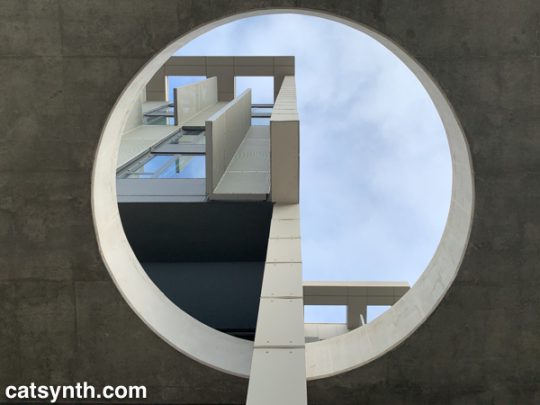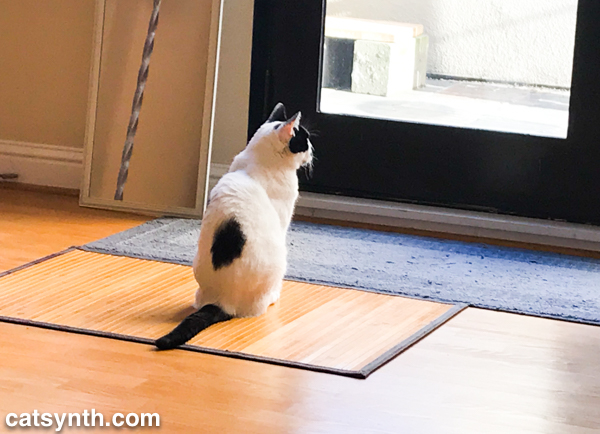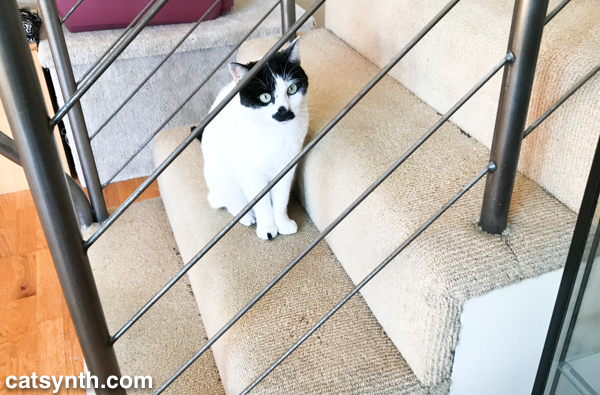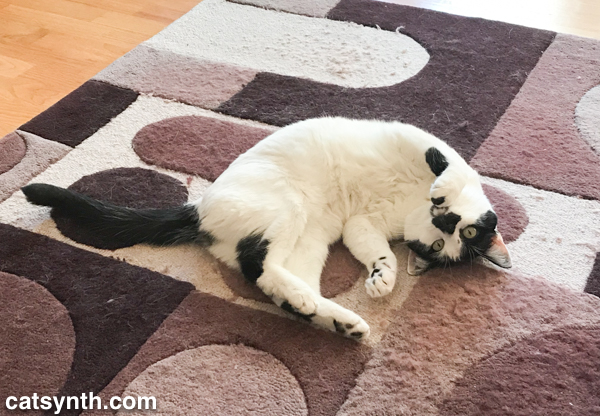
A particularly beautiful detail in one of the nearby apartment complexes in Mission Bay, San Francisco. I photographed it before (a couple of years ago), but from a different angle and lighting.

After several days of cold, wet, dreary weather, we finally have sunshine again. Not that we can really complain compared to our friends on the east coast after the recent storm. Sam Sam enjoys looking out the windows, though she hasn’t shown the same interest in venturing outside as Luna did.

I like the contrast of angular lines against Sam Sam’s natural shape in this one. One can see more of this geometric contrast in this pose on the stairs.

It’s a treat to capture such an image. But we also enjoy the everyday antics, such as Sam Sam’s patented “Scratch and roll.” It’s her way of currying favor.

It’s always a good day with Sam Sam. We hope you have a wonderful day, too.

Luna has long been comfortable in her modernist surroundings, at it is a common subject of her weekend visits to CatSynth. In the photo above, she is striking one of her attention-getting cute poses against the circular geometry of the rug and the angular lines of the glass table.

In those photo, she has a more elegant pose, the classic “reclining cat” from many works of art. But she also has a little bit of attitude and disdain her expression, probably directed towards me for snapping pictures.
The Carnival of the Cats will be hosted by Ritzi iInfidel.
And the Friday Ark is at the modulator.
I have been meaning to write reviews on some recent exhibitions I have seen set SFMOMA: the selections from Fisher Collection and New Topographics photography exhibition, both of which I have actually seen multiple times. This article covers the Fisher Collection, which will be closing this coming Sunday, September 19.
I have been spending some time thinking about what it means to write “CatSynth reviews” for a major exhibition like this about which so much has already been written. In the end, it’s about personal significance. It was really a microcosm of many of the exhibitions and artists that I have followed or discovered over many years – indeed, the exhibition included artists that i had first discovered through retrospectives at SFMOMA including William Kentridge and Chuck Close, or artists such as Ellsworth Kelly and Sol LeWitt whom I have gotten to know better through the museum’s programs. It is also an opportunity to explore what does (and does not) captivator me with modern art.
One of the things I find most compelling about modern art is the simplicity and sense of calmness I can feel in its presence. This is particularly true of the more minimalist and geometrically inspired works shown on the upper floor of the exhibition. This included those labeled formally as minimalism like Sol LeWitt, but also the large monochromatic panels of Ellsworth Kelly and Richard Serra’s geometric metal sculptures.

[Installation view with Janus by Gerhard Richter (1983) and multiple pieces by Richard Serra. San Francisco Museum of Modern Art.]
There is something about this type of art that I find very comforting, especially in a large scale presentation like this. I can focus on lines and curves and colors and nothing else. I can get absorbed into the repeating variations in Sol LeWitt’s drawings and sculpture, or allow my mind to go blank in Ellsworth Kelly’s simple series of panels. (Perhaps this is what made the placement of Anselm Kiefer’s straw-infused works inspired by the Holocaust in the middle of the same gallery all the more jarring.)

[Ellsworth Kelly, Blue Green Black Red (1996). San Francisco Museum of Modern Art]
Even Alexender Calder’s more organic forms fit into this category and were placed together with the others on the upper floor of the exhibit. It would be interesting to consider Calder’s curving but solid mobiles next to the intricate and delcate straight lines in LeWitt’s Hanging Structure 28c and Antony Gormley’s Quantum Cloud VIII.


[Alexander Calder, Eighteen Numbered Black (1953) . Sol LeWitt, Hanging Structure 28c (1989).]
LeWitt also touches on my interest in mathematics and algorithms (and technology) in art, and conceptual art, most notably in his Wall Drawing, which was created directly on the wall of the gallery in colored pencil from the artist’s specifications.
Gerhard Richter was a bridge between the minimalist and geometric art and the other parts of the collection. His Farben 256 with its array of solid-color rectangles was closer to the previously described works (and although I liked it I couldn’t help but think of a paint chart). Other pieces were more photographic – my favorite of these was Verwaltungsgebaude with its modern arctecture and motion.
The other direction that my artist interests tend is towards urban environments, including graffiti or industrial scenes. Cy Twombly’s large paintings in the exhibition feature repeated curving scribbles that remind me of the graffiti that I often photograph. The white scribbles on gray background in Untitled (Rome) reminded me specifically of walls I saw shooting photos in Warm Water Cove.
Twombly was placed along other works from the middle of the century. A large-scale piece by Lee Krasner was prominently featured (I have yet to see a solo retrospective of her work). A canvas with bright blue by Sam Francis caught my attention. The permanent collection of SFMOMA prominently features works by Richard Diebenkorn, and I think I liked those more than his work in this collection.
In addition to minimalist and geometric works, I also tend to notice art with a playful or surreal nature, or things that are particularly unique. William Kentridge’s installation based on Mozart’s The Magic Flute falls in this category. He built an entire miniature stage with archival photographs and moving images set to selections from the opera. While much more elaborate and complex than the previous works, the performance was still very arresting.
Strictly speaking, there was relatively little photography in the exhibition (although many of the paintings seemed derived from photographic sources). Of the few photographs, the strongest was an image by Sophie Calle which depicted a decaying bed in a courtyard of an apartment building, and was accompanied by a rather morbid story. Another of the featured photos, John Baldessari’s Blue Moon Yellow Window, Ghost Chair was quite painting-like with its extreme contrast and colored overlays.
I certainly did not touch upon everything within the exhibition in this brief review, so those who are interested are encouraged to check out the online exhibition page, or visit if you are in the area in the next five days.
[The photos in this article can be seen on flickr. You can also see photos by others tagged SFMOMA on flickr or via SFMOMA’s online communities page.]